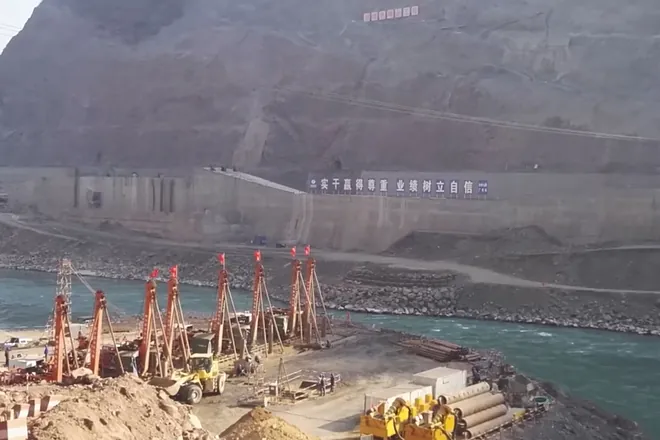When engineers finished filling China’s Three Gorges Dam in 2010, the world marveled at the engineering. It remains the largest hydroelectric plant ever built, with a reservoir holding around 40 trillion liters of water. But satellites soon detected something even more astonishing: by redistributing so much mass on Earth’s surface, the reservoir caused the planet’s axis to shift by about two centimeters and shortened the length of a day by a few microseconds.

That was just the prelude.
In August 2025, Beijing announced it had begun full-scale construction on a new hydroelectric project in Tibet—an undertaking almost three times the scale of Three Gorges. The new Yarlung Tsangpo hydropower station, slated for completion by 2030, is already being called the “Project of the Century.” If successful, it will generate more electricity than all of France’s nuclear reactors combined, at a cost of roughly $165 billion.
The engineering triumph is undeniable. But as with Three Gorges, questions reach beyond local ecology or geopolitics. At this scale, a dam does not only hold back a river. It reshapes sediment flows, alters monsoon rhythms, and redistributes planetary mass. And that last effect forces scientists to ask: when humanity moves rivers on this scale, how much does it move Earth itself?
Why Tibet? The Physics of Falling Water
Hydroelectricity works on a simple principle: water at a higher elevation contains gravitational potential energy. When it drops, that energy can be converted into motion and then into electricity via turbines. The larger the drop—the “head height”—the greater the power yield.
The Yarlung Tsangpo River, which arcs across Tibet before plunging into India and Bangladesh, provides a nearly perfect site. Over a stretch of just 50 kilometers, the river drops a staggering 2,000 meters. For comparison, that’s like Niagara Falls stacked on top of itself nearly 40 times.
By capturing that fall, engineers can generate immense amounts of electricity without needing an enormous horizontal reservoir. The steep topography means less surface area flooded per unit of power—one reason Beijing sees the site as a jewel for “clean” energy.
Still, “clean” is relative. To build a dam that can take advantage of such a drop requires not only billions of tons of concrete but also a reservoir large enough to stabilize water flow year-round. And that’s where physics begins to scale up into planetary consequences.
Dams and the Earth’s Spin
Earth is not a perfectly rigid sphere—it’s more like a slightly squishy top. Its spin is governed by the law of conservation of angular momentum, which means its rotation depends on how mass is distributed relative to its axis.
Think of a figure skater: arms pulled in, they spin faster; arms extended, they slow. Earth behaves the same way. Move enough mass closer to or farther from the axis, and the rotation changes.
What happened at Three Gorges
NASA calculated that the impoundment of Three Gorges shifted about 40 trillion kilograms of water. Because the reservoir sits away from the equator, this redistribution caused:
- A 2-centimeter shift in Earth’s axis.
- A shortening of the day by about 0.06 microseconds.
Tiny effects, yes. But measurable. And symbolic: for the first time, a human-engineered project registered on the same scale as natural geophysical processes.
Scaling up to Yarlung Tsangpo
If the Tibetan project impounds two to three times as much water, the shift could be proportionally larger. That might mean a several-centimeter axial adjustment and additional microsecond changes in day length.
In absolute terms, these shifts pale next to the glacial melt in Greenland and Antarctica, which has already moved Earth’s axis by tens of centimeters over the last few decades. Groundwater pumping and sea-level rise are also larger contributors. Still, the Tibetan project is unique: it represents a conscious engineering decision rather than an unintended byproduct of climate change.
It’s humanity deliberately placing a new weight on Earth’s spinning surface—and that makes it both scientifically fascinating and politically charged.
The Hidden Physics: Earth’s Moment of Inertia
To understand why these shifts matter, scientists turn to the moment of inertia—a measure of how resistant a spinning object is to changes in its rotation. Earth’s moment of inertia is dominated by its massive iron core and thick mantle. But surface water—oceans, ice, reservoirs—still matters.
- Greenland’s ice sheet, when it melts, transfers water from a high-latitude position (nearer the axis) into the oceans (closer to the equator), changing Earth’s inertia and nudging its spin.
- Reservoirs like Yarlung Tsangpo’s act in the opposite way: they gather water into a fixed location, concentrating mass that once was moving dynamically through the hydrological cycle.
Every large dam is, in effect, a local experiment in planetary mechanics. Usually the shifts are minute. But at Tibetan scale, they register on the same instruments used to track polar motion and tectonic drift.
More Immediate Risks: Sediment and Seismic Stress
While the planetary spin effects capture headlines, most scientists point to nearer-term risks as more urgent.
Sediment strangulation
The Yarlung Tsangpo is a sediment-heavy river. Each year it carries millions of tons of sand, silt, and organic material downstream—nutrients that recharge floodplains in India and Bangladesh. Dams trap this sediment behind their walls.
- Farmers downstream may see soil fertility decline as less silt reaches croplands.
- Reservoir capacity gradually shrinks as trapped sediment builds up, reducing the dam’s long-term efficiency.
Three Gorges already faces these problems, and Tibetan geology suggests an even higher sediment load.
Reservoir-induced earthquakes
Adding billions of tons of water to a confined valley does more than shift global inertia—it presses directly on faults. In seismically active zones, that can trigger earthquakes.
India’s northeast and Tibet are riddled with fault lines. Past studies have linked reservoir-induced seismicity to quakes in China, India, and even the United States. The risk is not just hypothetical.
Water Politics and Monsoon Rhythms
The Yarlung Tsangpo doesn’t stop at China’s border. It becomes the Brahmaputra River, feeding India’s Assam region before spilling into Bangladesh’s delta, where over 160 million people depend on its flow.
- India fears that China could control the timing of water releases, effectively turning the river into a political bargaining chip.
- Bangladesh fears that upstream storage will reduce both water flow and sediment delivery, compounding climate-change-driven sea-level rise.
Even if Beijing honors water-sharing agreements, dams alter the seasonal pulse of rivers. Monsoon floods, once predictable, may arrive weaker or out of sync, disrupting centuries-old farming patterns.
The Climate Argument
From Beijing’s perspective, the case is simple:
- China remains the world’s largest emitter of carbon dioxide.
- Coal still generates over half its electricity.
- To meet climate pledges, it must massively scale up renewables.
Hydropower provides a domestic, reliable, zero-carbon option. By framing the Tibetan dam as part of the clean energy transition, China positions itself as tackling global climate goals—even if local costs are high.
Critics counter that large dams are not truly “green”:
- Flooded valleys release methane as vegetation decomposes.
- Relocated communities face cultural and economic upheaval.
- Biodiversity is often permanently lost.
In effect, the Tibetan project pits global carbon benefits against regional ecological and social harms—a tradeoff that defines many megaprojects of the Anthropocene.
A Planetary Scale Perspective
Step back, and the Tibetan megadam is not unique. Humanity has been redistributing Earth’s water for centuries.
- Groundwater pumping in the U.S. and India has moved enough mass to tilt Earth’s axis by almost 80 centimeters since the 1990s.
- Melting glaciers are shifting trillions of tons of mass annually from land to ocean.
- Urbanization concentrates concrete, steel, and water use in ways that subtly tweak Earth’s balance.
The Tibetan project is another layer on that pile—a dramatic example of how local engineering decisions can cascade into planetary consequences.
What Scientists Will Watch
Over the next decade, researchers will monitor:
- Polar motion: Satellites will track whether the dam measurably alters Earth’s axis.
- Seismic activity: Geologists will look for unusual tremors near the reservoir.
- River chemistry and sediment: Ecologists will study nutrient changes downstream in India and Bangladesh.
- Methane flux: Climate scientists will measure greenhouse gas release from flooded areas.
These measurements won’t just reveal the dam’s impact. They’ll also feed into a broader picture of how humanity’s reshaping of water cycles interacts with Earth’s geophysics.
How a Dam Moves the Earth: 3 Quick Physics Facts
1. Reservoirs act like giant weights
- Filling a dam traps billions of tons of water in one place.
- That mass presses down on Earth’s crust and shifts the planet’s mass distribution.
2. The “figure skater” effect
- Earth spins like a skater.
- When mass moves farther from or closer to the axis, the spin adjusts.
- Result: tiny changes in day length (microseconds) and a shift in the axis (centimeters).
3. Dams vs. melting ice
- Three Gorges Dam shortened Earth’s day by ~0.06 microseconds.
- Melting Greenland ice shifts the axis by tens of centimeters.
- The Tibetan megadam will be bigger than Three Gorges, but still small compared to global ice melt—though far more concentrated in one spot.
The Yarlung Tsangpo hydroelectric project is more than an engineering feat. It is a planetary-scale experiment—an attempt to harness a river so powerful that it will generate more electricity than the nuclear capacity of an entire G7 nation.
But the costs are profound. Downstream nations fear water scarcity. Ecologists warn of sediment starvation and methane emissions. Geophysicists worry about seismic risks and planetary inertia shifts.
If Three Gorges was a symbol of China’s rise, the Tibetan megadam will be a symbol of the Anthropocene: humanity’s ability to engineer at scales once reserved for tectonic plates and ice ages.
In the end, the project forces us to confront a paradox. To fight climate change, we seek clean energy. But in doing so, we reshape rivers, ecosystems, and even the spin of Earth itself. Whether that gamble pays off will not be known until long after the turbines first turn in 2030.







